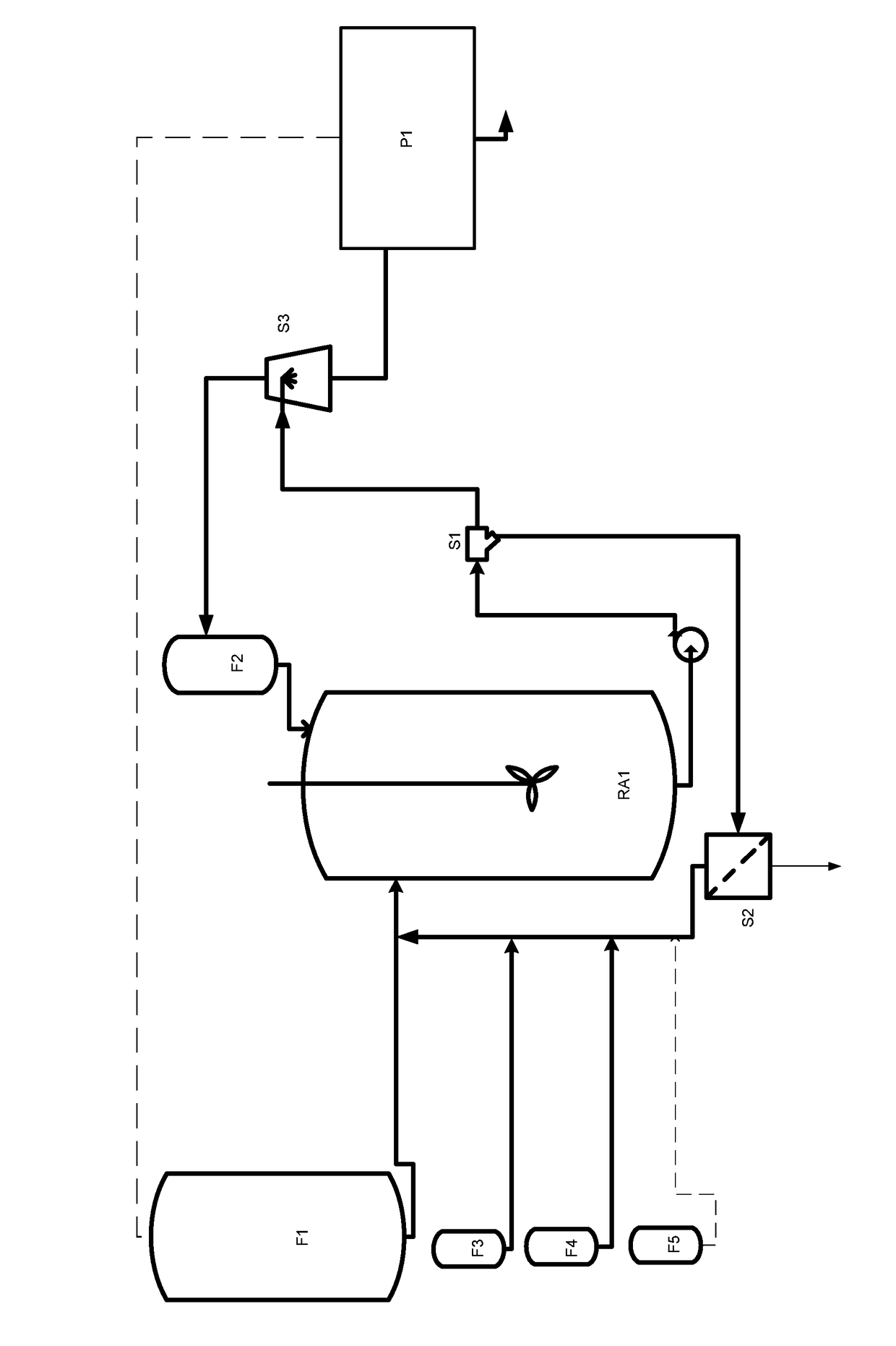Production of fatty acid alkyl esters
a technology alkyl esters, which is applied in the direction of fermentation, biofuels, etc., can solve the problems of re-use and not currently used enzyme technology in commercial biodiesel production, and achieve the effect of reducing the percentage of free fatty acids, reducing the rate and increasing the percentage of fatty acid alkyl esters
- Summary
- Abstract
- Description
- Claims
- Application Information
AI Technical Summary
Benefits of technology
Problems solved by technology
Method used
Image
Examples
example 1
[0064]Fatty acid methyl esters (FAME) were produced by transesterification of soybean oil with Lipase A using different glycerol-water to triglyceride ratios and different ratios of water in the glycerol-water phase. The following parameters were varied in the experiment setup (see table 1).
[0065]
TABLE 1Glycerol-water phase in % of reactant mixture and% of water in the glycerol-water phase tested.Glycerol-water phase, %203040Amount of water in the050100glycerol-water phase, %
[0066]
TABLE 2The 9 treatments comprised oil, glycerol, water, methanoland enzyme according to the scheme below.EnzymeOil (g)Glycerol (g)Water (g)Methanol (g)dosage (ml)18021.300.0428111.300.0438201.300.0447031.140.035571.51.51.140.03567301.140.03576040.980.03086220.980.03096400.980.030
[0067]Glass reactors (20 ml volume) with glass filter bottom were used. The glass filter was wetted with a small amount of oil before the enzyme was added.
[0068]Methanol dosage was 1.5 molar equivalents to the total fatty acids, co...
example 2
[0073]Fatty acid ethyl esters (FAEE) were produced by transesterification of soybean oil. Soybean oil, glycerol and water in the ratio 8:1:1 (800 g:100 g:100 g) were added to the reactor with an enzyme dosage of 5 g Lipase A / kg oil. The reactor was incubated at 35° C. and stirring at 1000 rpm. Ethanol (96%) in a total dosage of 1.3 molar equivalents to the total fatty acids (168.9 g) was added continuously over the first 5 hours and 25 minutes.
[0074]Samples of 1 ml were drawn at 1, 2, 3, 4, 5, 6, 23, and 32 hours and evaporated in a vacuum concentrator at 60° C. for 1½ hour to eliminate excess ethanol. Yield of fatty acid ethyl esters was quantified by gas chromatography. The results are shown in table 4.
[0075]
TABLE 4FAEE (ethyl esters) and FFA (free fattyacids) over time as % in the fatty phase.Time, hoursFAEE, %FFA, %113.317.5216.413.0537.97.72262.67.73273.97.35088.57.4
example 3
[0076]Water:glycerol:soybean oil was mixed in the ratio 1:1:8 (2 g:2 g:16 g) or 0.5:1.5:8 (1 g:3 g:16 g) and reacted with lipase (Lipase B) in an amount of 0.5% w / w of oil at 35° C. for 48 hours. Methanol, 1.5 molar equivalents to the total fatty acids was added with 0.25 molar equivalents from start and after 1 hour, the rest after 3 hours. The results are shown in table 5.
[0077]
TABLE 5Analysis of FFA and FAME after 48 hours.Water:glycerol (%)FFA (%)FAME (%)50:503.593.825:752.295.9
[0078]The high addition of glycerol (b-set of data) resulted in lower FFA and a high production of FAME. A higher percentage of FAME was achieved for the high glycerol addition. This is surprising considering that glycerol is a reaction product from the transesterification and it would be expected to reduce the FAME formation by pushing the equilibrium of the reaction towards triglyceride formation.
PUM
| Property | Measurement | Unit |
|---|---|---|
| w/w | aaaaa | aaaaa |
| w/w | aaaaa | aaaaa |
| w/w | aaaaa | aaaaa |
Abstract
Description
Claims
Application Information
 Login to View More
Login to View More - R&D
- Intellectual Property
- Life Sciences
- Materials
- Tech Scout
- Unparalleled Data Quality
- Higher Quality Content
- 60% Fewer Hallucinations
Browse by: Latest US Patents, China's latest patents, Technical Efficacy Thesaurus, Application Domain, Technology Topic, Popular Technical Reports.
© 2025 PatSnap. All rights reserved.Legal|Privacy policy|Modern Slavery Act Transparency Statement|Sitemap|About US| Contact US: help@patsnap.com

